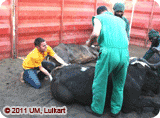Macro- Micro-parasite Interactions: Dynamics of Co-infection and Implications for Disease Control

Summary:

Within-host parasite interactions and their effects on infectious disease dynamics have been largely overlooked, despite the fact that most hosts are infected with multiple parasite species. Coinfections can modify the effects of infectious disease on hosts in several different ways. For example, in humans, susceptibility to and severity of microparasitic infections such as HIV, TB and malaria may be correlated with the intensity and prevalence of macroparasite (nematode) infections.

In wildlife little is known about interactions between macroparasites and microparasites, but initial work on African buffalo (Syncerus caffer) suggests that there is a strong negative correlation between bovine tuberculosis (BTB; Mycobacterium bovis) and gastrointestinal (GI) nematode infections. This negative pattern may be explained by one or more of the following mechanisms: (1) immunological cross-regulation: hosts that successfully suppress nematode infections cannot defend themselves against BTB infection because activation of immune cells targeting nematodes (Th2 cells) inhibits immune cells targeting BTB (Th1 cells); (2) accelerated mortality: hosts infected with both nematodes and BTB die at a faster rate, leading to a relative absence of individuals infected with both parasites; (3) genetic resistance: individuals with high levels of resistance to nematodes are predisposed to BTB infection due to natural variation in investment in Th1 vs. Th2 immunity.
With PI Vanessa Ezenwa and collaborators (Dr. Anna Jolles et al.), we have been testing among the three mechanisms above. Our genetics laboratory has genotyped SNPs and microsatellites in the IFNG (interferion gamma) gene and detected correlations between IFNG genotype and macro-parasite abundance in buffalo (Below).
Collaborators:
Vaness Ezenwa (PI), Dr. Anna Jolles, et al.,
Publications:
- Archie, E.A., G. Luikart, and V. Ezenwa. 2009. Infecting epidemiology with genetics: A new frontier in disease ecology. Trends in Ecology and Evolution, In press.
- Ezenwa et al. Microparasite – Macroparasite Interactions: Dynamics of Co-infection in African buffalo. Submitted.
